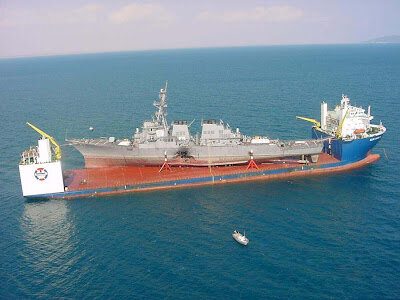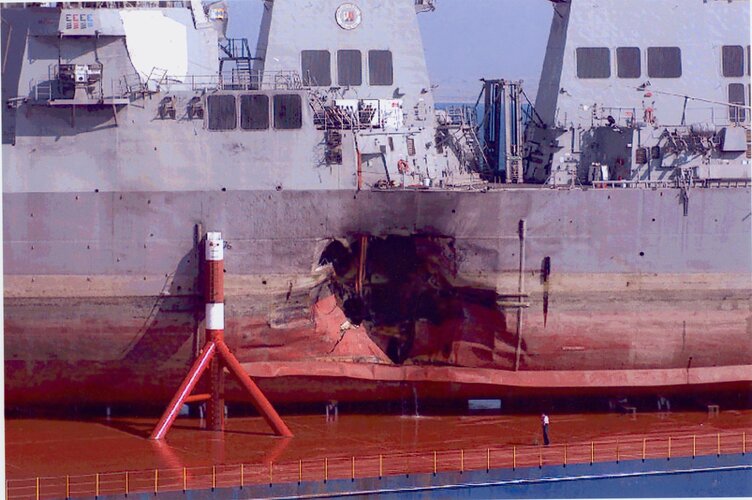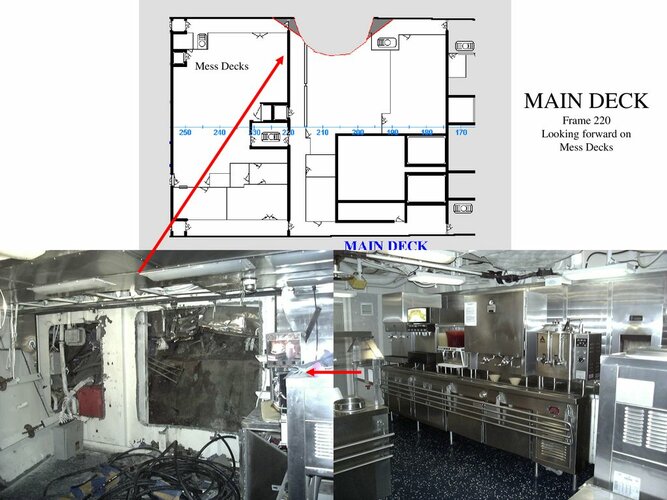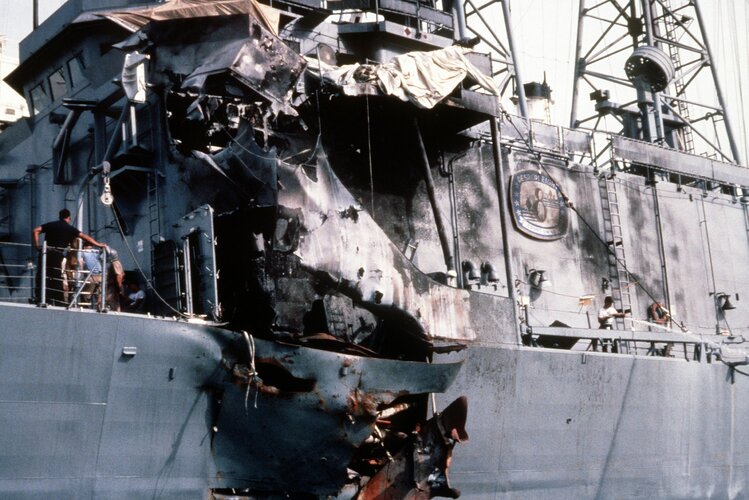You are using an out of date browser. It may not display this or other websites correctly.
You should upgrade or use an alternative browser.
You should upgrade or use an alternative browser.
A modern frigate?
- Thread starter uk 75
- Start date
johnpjones1775
ACCESS: Secret
- Joined
- 27 May 2023
- Messages
- 207
- Reaction score
- 31
You mean like an OHP being smaller and surviving a mine strike, or surviving 2 ASMs hitting it?Look at the size and position of the hole. Now imagine a smaller, less compartmentalised ship suffering the same attack.
View attachment 703957
Like that? Pretty sure both incidents had heavier warheads and the ships survived in both cases.
A larger ship often means larger crew increasing the likelihood for more casualties.
johnpjones1775
ACCESS: Secret
- Joined
- 27 May 2023
- Messages
- 207
- Reaction score
- 31
Doubling back to this picture the cole strike was where the mess deck was, there were none of the damage reduction measures depicted here on the mess decks…which is depicted here…if you know where the mess deck of a burke is located you’d know that posting this 100% useless.
A Tentative Fleet Plan
I really should change my personal text
- Joined
- 9 April 2018
- Messages
- 946
- Reaction score
- 1,886
Based on what?
15 crew were killed, I’d say the casualties were maximized.
What about the 37 wounded?
The ship stayed afloat, none of the crew drowned after having to abandon ship, which may have been the case with a smaller vessel.
Point being when there’s a war on casualties are inevitable. They still occurred before we were even at war.
All the more reason to minimise those casualties then, especially given the importance of trained personnel.
So attempting to prevent any casualties by throwing money at ships so we can’t afford the to reach the fleet size the navy says we need to reach?
That makes perfect sense.
As opposed to building and crewing ships that still can't be afforded, and also useless death traps that endanger those that sail in them and cannot defend themselves? That fleet of small ships use propose would still need to be crewed, and given the personnel numbers required would probably work out having a greater cost than a conventional fleet of DDGs and FFGs.
A larger ship often means larger crew increasing the likelihood for more casualties.
Larger ships can have smaller crews than smaller ships in some cases, because they can have a better layout ensuring better access for maintenance.
Larger ships are will minimise crew casualties, because they have more protection, more redundancy, and can continue to float, move and fight after damage which would cripple or sink smaller ships.
Surprisingly enough, a smaller ship sinking quickly will kill more of its crew than a larger ships remaining afloat or succumbing slowly to to damage caused by the same weapon, let alone if the larger ship remains afloat.
A greater amount of Stark's crew, both in terms of proportion and absolute numbers were killed than in the US Cole.You mean like an OHP being smaller and surviving a mine strike, or surviving 2 ASMs hitting it?
Like that? Pretty sure both incidents had heavier warheads and the ships survived in both cases.
Stark was also mission-killed, whereas Cole lost her forward machinery spaces. Depending on shock damage to various radars etc, she could probably limp to a nearby port if necessary, and continue to defend herself against hostile air, surface and subsurface targets in the meantime. The length of the damaged area open to flooding can't have more then 2 compartments long (not including the aft engine room) something that should have been easily survivable for a modern DDG, especially given the Cole was hit by suicide boat, not anti-ship missiles with all of the attendant problems that come with that, like fires and significant fragmentation damage punching small holes everywhere, causing progressive flooding.
Last edited:
johnpjones1775
ACCESS: Secret
- Joined
- 27 May 2023
- Messages
- 207
- Reaction score
- 31
Lol.The ship stayed afloat, none of the crew drowned after having to abandon ship, which may have been the case with a smaller vessel.
All the more reason to minimise those casualties then, especially given the importance of trained personnel.
As opposed to building and crewing ships that still can't be afforded, and also useless death traps that endanger those that sail in them and cannot defend themselves? That fleet of small ships use propose would still need to be crewed, and given the personnel numbers required would probably work out having a greater cost than a conventional fleet of DDGs and FFGs.
Larger ships can have smaller crews than smaller ships in some cases, because they can have a better layout ensuring better access for maintenance.
Larger ships are will minimise crew casualties, because they have more protection, more redundancy, and can continue to float, move and fight after damage which would cripple or sink smaller ships.
Surprisingly enough, a smaller ship sinking quickly will kill more of its crew than a larger ships remaining afloat or succumbing slowly to to damage caused by the same weapon, let alone if the larger ship remains afloat.
A greater amount of Stark's crew, both in terms of proportion and absolute numbers were killed than in the US Cole.
Stark was also mission-killed, whereas Cole lost her forward machinery spaces. Depending on shock damage to various radars etc, she could probably limp to a nearby port if necessary, and continue to defend herself against hostile air, surface and subsurface targets in the meantime. The length of the damaged area open to flooding can't have more then 2 compartments long (not including the aft engine room) something that should have been easily survivable for a modern DDG, especially given the Cole was hit by suicide boat, not anti-ship missiles with all of the attendant problems that come with that, like fires and significant fragmentation damage punching small holes everywhere, causing progressive flooding.
Stark was mission killed so was the Cole.
Again stark was a smaller ship hit by more explosive weight, and more attendant problems as you said.
Much comes down to luck good or bad, since as it so happens most of those killed on Stark died asleep in their racks since one missile hit a berthing space at night.
But the point being that losing something like an OHP is less of a hit than losing something like a burke.
You make all sorts of random claims like smaller ship sinking quickly with no actual basis.
A Tentative Fleet Plan
I really should change my personal text
- Joined
- 9 April 2018
- Messages
- 946
- Reaction score
- 1,886
Lol.
Stark was mission killed so was the Cole.
Again stark was a smaller ship hit by more explosive weight, and more attendant problems as you said.
The explosive mass of the warhead which hit Cole and the two Exocet warheads which hit Stark were very similar, Cole was hit on the waterline leading to more flooding, whereas Stark had to deal with fires caused by the missile fuel and fragmentation damage from the missile airframes and engines etc.
Much comes down to luck good or bad, since as it so happens most of those killed on Stark died asleep in their racks since one missile hit a berthing space at night.
And most of Cole's casualties were the result of the bomb detonating next to the galley when the crew were lining up for lunch. Bad things happen in wars people get killed, which is why we try to minimise the number of people who get killed. We give them first aid training, body armour, AFVs, and large surface combatants with fragment protection, redundant machinery spaces and plenty of reserve buoyancy to keep them alive.
But the point being that losing something like an OHP is less of a hit than losing something like a burke.
Cole lost her forward machinery spaces and that was it, she was still capable of fighting if necessary. She was not close to sinking, not with only two compartments flooding. Radars were intact, CIC was intact, VLS cells where untouched, aft engine room was un-flooded and still able to propel the ship, unless shock damage knocked out any of the above then Cole could have still defended herself.
As for losing a Burke instead on an OHP, the latter is always more likely to happen since the OHP is less able to defend itself, and is smaller and less resilient.
You make all sorts of random claims like smaller ship sinking quickly with no actual basis.
Smaller ships are more vulnerable to damage, have less reserve buoyancy, separation of machinery, of course they suffer more damage or sink faster if hit with an equivalent weapon Vs one hitting a larger ship. That's just basic facts, very simple to understand.
Last edited:
- Joined
- 6 November 2010
- Messages
- 4,242
- Reaction score
- 3,185
USS Stark was hit by two Exocet missiles, the first of which didn't explode. Exocet has a 165 kg warhead. After the second hit, Stark had a 3x4 m gash in its side.
Robert Finke, a former CIA officer had this to say on the attack on USS Cole:
Robert Finke, a former CIA officer had this to say on the attack on USS Cole:
After the attack, USS Cole had a much bigger gash than Stark's, likely caused by a shaped charge, exploding below the waterline. The size of the gash alone should be enough to point to a different order of magnitude for the attack.ROBERT FINKE, FMR. INTELLIGENCE OFFICER, CIA: Well, Roger, based on what I've seen, I have some difficulty. I think it's a very complex situation here. Number one, I have not heard conclusively was the boat fiberglass or was it a Zodiac type. If it were, say, the fiberglass type, they could have had explosives, either very high like Symtex or some other type of explosive, molded to form a shape charge.
Now, based on the hole in the side of the ship, I have a strong feeling that some of those explosives were carried below the water line on that boat that went up to help moor it.
Now, as for an imprint, once the immediate search team gets in there -- well, they're already in there now, they're going to start in the blast area and work outwardly. And they are going to be able to make determinations from some of the residue just from field testing there -- there's several field tests they can do -- of possibly what type of explosive it was.
Again, I feel like, just watching all the coverage on it, that it was some type of shape charge. I don't think that boat could have held thousands of pounds of explosives.
Attachments
Last edited:
- Joined
- 27 September 2006
- Messages
- 5,744
- Reaction score
- 5,643
The discussion here seems to reflect the historical ones that led to a mix of high and low end ships.
It is interesting to note how all navies have shrunk drastically since the Cold War (except for China and India).
As budgets get squeezed and fewer shipyards are available it has become much harder to maintain navies. Alternatives like aircraft and small patrol vessels have filled the void.
The loss of the Moskva and the woes of the Peter and Kuznetzov major units suggest that Russia is not going to generate much of a naval threat any time soon. China's navy has some fine looking ships but apart from anti piracy patrols no combat experience.
The South American navies notably Brazil and Chile have some impressive Cold War legacy vessels but it is hard to see these being replaced in quantity.
China must look at the well trained and equipped navies of a range of countries from Australia to South Korea with some concern. As for the United States it is hard to see Chinese warships surviving long in a shooting war.
It is interesting to note how all navies have shrunk drastically since the Cold War (except for China and India).
As budgets get squeezed and fewer shipyards are available it has become much harder to maintain navies. Alternatives like aircraft and small patrol vessels have filled the void.
The loss of the Moskva and the woes of the Peter and Kuznetzov major units suggest that Russia is not going to generate much of a naval threat any time soon. China's navy has some fine looking ships but apart from anti piracy patrols no combat experience.
The South American navies notably Brazil and Chile have some impressive Cold War legacy vessels but it is hard to see these being replaced in quantity.
China must look at the well trained and equipped navies of a range of countries from Australia to South Korea with some concern. As for the United States it is hard to see Chinese warships surviving long in a shooting war.
- Joined
- 6 September 2006
- Messages
- 4,338
- Reaction score
- 7,549
Good damage control is key.
Many a fine ship has been lost through inept damage control and poor quality control in construction. Others with excellent attention to detail, skill and training have survived damage that should have by rights sunk them (think HMS Kelly).
Where the hit lands is open to luck - could be the worst conceivable place to be hit or the luckiest to escape with barely a scratch. But when it lands you have to be ready for both cases.
Many a fine ship has been lost through inept damage control and poor quality control in construction. Others with excellent attention to detail, skill and training have survived damage that should have by rights sunk them (think HMS Kelly).
Where the hit lands is open to luck - could be the worst conceivable place to be hit or the luckiest to escape with barely a scratch. But when it lands you have to be ready for both cases.
johnpjones1775
ACCESS: Secret
- Joined
- 27 May 2023
- Messages
- 207
- Reaction score
- 31
Being capable of fighting and being mission killed are two separate things.The explosive mass of the warhead which hit Cole and the two Exocet warheads which hit Stark were very similar, Cole was hit on the waterline leading to more flooding, whereas Stark had to deal with fires caused by the missile fuel and fragmentation damage from the missile airframes and engines etc.
And most of Cole's casualties were the result of the bomb detonating next to the galley when the crew were lining up for lunch. Bad things happen in wars people get killed, which is why we try to minimise the number of people who get killed. We give them first aid training, body armour, AFVs, and large surface combatants with fragment protection, redundant machinery spaces and plenty of reserve buoyancy to keep them alive.
Cole lost her forward machinery spaces and that was it, she was still capable of fighting if necessary. She was not close to sinking, not with only two compartments flooding. Radars were intact, CIC was intact, VLS cells where untouched, aft engine room was un-flooded and still able to propel the ship, unless shock damage knocked out any of the above then Cole could have still defended herself.
As for losing a Burke instead on an OHP, the latter is always more likely to happen since the OHP is less able to defend itself, and is smaller and less resilient.
Smaller ships are more vulnerable to damage, have less reserve buoyancy, separation of machinery, of course they suffer more damage or sink faster if hit with an equivalent weapon Vs one hitting a larger ship. That's just basic facts, very simple to understand.
A mission kill is any damage sustained that would prevent a ship from continuing or completing its mission effectively.
Considering the cole was pulled off deployment it’s a mission kill, let alone the fact she would have been pulled from whatever war time mission she was on with that kind of damage.
Splinter protection will be on smaller cheaper ships, but it’s in so few places that it really doesn’t even matter the funny part is splinter protection isn’t even meant to protect the crew and save lives it’s meant to protect equipment.
There’s a reason every soldier and marine grunt isn’t trained and equipped to the same degree as tier 1 operators.
If they were fewer would likely die and be injured
Last edited:
johnpjones1775
ACCESS: Secret
- Joined
- 27 May 2023
- Messages
- 207
- Reaction score
- 31
And what modern navy has more combat experience in the surface fleet than China?The discussion here seems to reflect the historical ones that led to a mix of high and low end ships.
It is interesting to note how all navies have shrunk drastically since the Cold War (except for China and India).
As budgets get squeezed and fewer shipyards are available it has become much harder to maintain navies. Alternatives like aircraft and small patrol vessels have filled the void.
The loss of the Moskva and the woes of the Peter and Kuznetzov major units suggest that Russia is not going to generate much of a naval threat any time soon. China's navy has some fine looking ships but apart from anti piracy patrols no combat experience.
The South American navies notably Brazil and Chile have some impressive Cold War legacy vessels but it is hard to see these being replaced in quantity.
China must look at the well trained and equipped navies of a range of countries from Australia to South Korea with some concern. As for the United States it is hard to see Chinese warships surviving long in a shooting war.
It’s also hard to see American ships surviving long in a shooting war.
johnpjones1775
ACCESS: Secret
- Joined
- 27 May 2023
- Messages
- 207
- Reaction score
- 31
Cole was hit by about 500lbs of explosivesUSS Stark was hit by two Exocet missiles, the first of which didn't explode. Exocet has a 165 kg warhead. After the second hit, Stark had a 3x4 m gash in its side.
Robert Finke, a former CIA officer had this to say on the attack on USS Cole:
After the attack, USS Cole had a much bigger gash than Stark's, likely caused by a shaped charge, exploding below the waterline. The size of the gash alone should be enough to point to a different order of magnitude for the attack.
Stark was hit by 2 Exocets. One detonated with its 364lb warhead the other didn’t, but both burned a lot of fuel.
The stark had significantly more damage done
Last edited:
- Joined
- 6 November 2010
- Messages
- 4,242
- Reaction score
- 3,185
It's hard to see any navy's ships surviving long in a shooting war.It’s also hard to see American ships surviving long in a shooting war
- Joined
- 6 November 2010
- Messages
- 4,242
- Reaction score
- 3,185
You have a source for that? Even Robert Finke was reduced to an educated guess about the nature of the attack, although, given the damage to USS Cole, a shaped charge seems plausible. I think an attack like that would have completely wrecked USS Stark.Cole was hit by about 500lbs of explosives
johnpjones1775
ACCESS: Secret
- Joined
- 27 May 2023
- Messages
- 207
- Reaction score
- 31
https://ctc.westpoint.edu/twenty-years-after-the-uss-cole-attack-the-search-for-justice/#:~:text=On%20October%2012%2C%202000%2C%20two,hole%20near%20the%20ship's%20galley.You have a source for that? Even Robert Finke was reduced to an educated guess about the nature of the attack, although, given the damage to USS Cole, a shaped charge seems plausible. I think an attack like that would have completely wrecked USS Stark.
It should be noted also that the ship nearly sank as a result of the attack.
Had she not been in port she likely would have been completely lost.
johnpjones1775
ACCESS: Secret
- Joined
- 27 May 2023
- Messages
- 207
- Reaction score
- 31
Exactly which is why in the end it will likely come down to who has more ships with the most offensive capabilitiesIt's hard to see any navy's ships surviving long in a shooting war.
johnpjones1775
ACCESS: Secret
- Joined
- 27 May 2023
- Messages
- 207
- Reaction score
- 31
Exactly which is why in the end it will likely come down to who has more ships with the most offensive capabilitiesIt's hard to see any navy's ships surviving long in a shooting war.
- Joined
- 6 November 2010
- Messages
- 4,242
- Reaction score
- 3,185
^I'm more of ATFP's opinion. Despite the giant hole, USS Cole's keel was intact.Cole lost her forward machinery spaces and that was it, she was still capable of fighting if necessary. She was not close to sinking, not with only two compartments flooding. Radars were intact, CIC was intact, VLS cells where untouched, aft engine room was un-flooded and still able to propel the ship, unless shock damage knocked out any of the above then Cole could have still defended herself.
johnpjones1775
ACCESS: Secret
- Joined
- 27 May 2023
- Messages
- 207
- Reaction score
- 31
Keel doesn’t need to be damaged for a ship to be mission killed or sink.^I'm more of ATFP's opinion. Despite the giant hole, USS Cole's keel was intact.
But I’m sure you guys know a lot more about the engineering and actual battle damage than the people who were on the ship when it happened, immediately after it happened, and the people who investigated the incident and surveyed the ship and it’s damage.
Yellow Palace
ACCESS: Top Secret
- Joined
- 5 May 2007
- Messages
- 1,054
- Reaction score
- 1,737
And funnily enough, those people - who have more knowledge of the actual threat than all of us here - didn't decide that the solution was lots of small, cheap, vulnerable ships.But I’m sure you guys know a lot more about the engineering and actual battle damage than the people who were on the ship when it happened, immediately after it happened, and the people who investigated the incident and surveyed the ship and it’s damage.
Scott Kenny
ACCESS: Above Top Secret
- Joined
- 15 May 2023
- Messages
- 6,188
- Reaction score
- 5,039
Those big USVs still require someone to do maintenance eventually. You know, weekly oil filter changes, things like that. Which means a larger ship close by to deliver the working parties to do the maintenance.And so we are seeing a lot of experimentation with USVs and UAVs.
The US Navy is working toward 2000ton, heavily armed LUSVs which will be roughly the size of some of the concepts being talked about here.
The Constellation-class frigates are as big as they are because of the stability requirements of their radars. Despite being 3200 tons larger than a Perry, they only have 24 more crew. Perrys are listed as a crew of 176, Connies as 24 officers and 176 enlisted for a total of 200.Something which drives up the size of the ship significantly.
You also need to include however much rocket fuel would be left unburned at impact with a solid rocket missile.USS Stark was hit by two Exocet missiles, the first of which didn't explode. Exocet has a 165 kg warhead. After the second hit, Stark had a 3x4 m gash in its side.
Robert Finke, a former CIA officer had this to say on the attack on USS Cole:
After the attack, USS Cole had a much bigger gash than Stark's, likely caused by a shaped charge, exploding below the waterline. The size of the gash alone should be enough to point to a different order of magnitude for the attack.
Have you ever seen what happens when you ignite the entire rocket at once instead of start the burn from one end? Hint: KABOOM!!!
- Joined
- 6 November 2010
- Messages
- 4,242
- Reaction score
- 3,185
Indeed.You also need to include however much rocket fuel would be left unburned at impact with a solid rocket missile.
The explosive mass of the warhead which hit Cole and the two Exocet warheads which hit Stark were very similar, Cole was hit on the waterline leading to more flooding, whereas Stark had to deal with fires caused by the missile fuel and fragmentation damage from the missile airframes and engines etc.
johnpjones1775
ACCESS: Secret
- Joined
- 27 May 2023
- Messages
- 207
- Reaction score
- 31
Lol I mean they did, that’s about when the LCS moved from the street fighter program into the actual LCS program.And funnily enough, those people - who have more knowledge of the actual threat than all of us here - didn't decide that the solution was lots of small, cheap, vulnerable ships.
Too bad that program was so poorly managed.
However it would be great if y’all could actually debate in good faith and leave personal judgements out.
Edit
Within 3 years of Cole attack LCS was declared the navy’s top priority
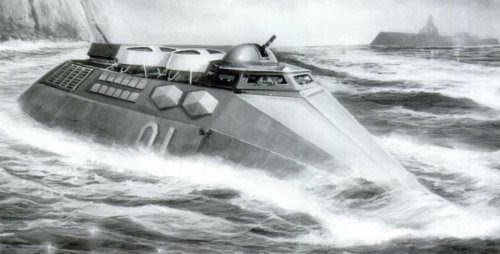
What Happened To Streetfighter?
Let’s start the new year with a post that may ruffle a few feathers and contradict some dearly held beliefs.. The LCS is an abject f...
Last edited:
A Tentative Fleet Plan
I really should change my personal text
- Joined
- 9 April 2018
- Messages
- 946
- Reaction score
- 1,886
LCS is hardly small, much larger than Streetfighter was intended to be.Lol I mean they did, that’s about when the LCS moved from the street fighter program into the actual LCS program.
Too bad that program was so poorly managed.
LCS has a useful role as basically Minesweeper Mothership that can self-deploy and self-escort against enemy FACs and Boghammers, not as a general-purpose frigate.
A Tentative Fleet Plan
I really should change my personal text
- Joined
- 9 April 2018
- Messages
- 946
- Reaction score
- 1,886
Depends on the Navy in question.Can we get back to discussing next generation frigates?
I quite liked the MEKO-300 design (although obviously the Poles didn't) and more generally the MEKO X-shaped superstructure enabling more redundancy and resistance to battle-damage in the radar layout.
I think high-end general purpose capabilities in Frigates make sense if you're planning to fight against peer-opponents where even second line roles require a lot of capability, or when it's going to be the most capable combatant in your fleet (i.e. minor European navies like Poland, Greece etc.). The requirements for those ships are basically going to be similar to that of Guided Missile Destroyers, but with less overall, fewer missiles, fewer or less powerful radars, less power for radars, lasers, High-Powered Microwaves, but hopefully enough for later additions. Ships like the FDI, Arrowhead 140, MEKO A300, and although larger and capable enough to the point where there comparable to the role of major European Frigates/Guided Missile Destroyers, the Constellations. If the smaller Frigates in the above list are still unaffordable for a nation, then high end corvettes like the Sa'ar 6 or the larger of the Gowind series.
I think the larger relatively-single purpose ships, like Type 26 or the French FREMM will evolve (or already have looking at the Australian and Canadian variants, or the Italian FREMM variant) into the high-end General-Purpose ships discussed above. I think they're too larg, too expensive and too valuable to be limited to local AAW only, and said limited AAW capabilities means they'll be incapable of independent action in high-threat environments, which is a terrible waste of such combatants.
I don't really see a role for small single-purpose vessels, they're too vulnerable to a greater variety of threats (21st Century Type 14s are not visible when modern SSNs and SSKs can launch anti-ship missiles).
I do see the potential of a high-low dichotomy of Large Surface Combatants/Guided Missile Destroyers, or if a country does not have enough resources Small Surface Combatants/Guided Missile Frigates acting as the high end, with OPVs performing assorted small ship tasks, but the latter will not be survivable in wartime, and and will it be intended to go anywhere near harms ways, being reduced to policing duties, flying the flag etc.
Last edited:
LCS is hardly small, much larger than Streetfighter was intended to be.
LCS has a useful role as basically Minesweeper Mothership that can self-deploy and self-escort against enemy FACs and Boghammers, not as a general-purpose frigate.
Maybe it can does those things. The MIW package is new. I don't think it's deployed with the MIW package yet.
The Freedom Class is being touted as the anti-boat swarm platform but it has yet to perform that mission. It's spent most of it's life tied to a pier waiting to get repaired.
the way I see it, if China-Taiwan kicks off, the US will need ASW escorts for eastern pacific work. I'm expecting convoys to Hawaii or maybe Midway or Guam as staging bases, or Adak up in the Aleutian Islands, and those could be dealt with by less capable DEs than anything working closer to China's A2AD zone. And anything in the Atlantic or Indian Ocean could also use those.
I agree. There would also be a need for ASW escorts to patrol chokepoints like the Malacca straits and the various island straits in Indonesia, to keep Chinese subs and commercial shipping “bottled” inside South East Asian waters and block their access to the Indian Ocean.
This mission could be done by an ocean-going ASW corvette or heavily upgunned Coast Guard cutter. Wouldn’t necessarily have to be very large, maybe as small as 2,000-2,500 tons.
I’ve mocked up an example below… this is closely based on a real design, the Gowind 200 from the mid-2000s. Changes include a conventional propulsion optimized for higher endurance, and a wave-piercing bow for better hydrodynamics and reduced radar cross section.
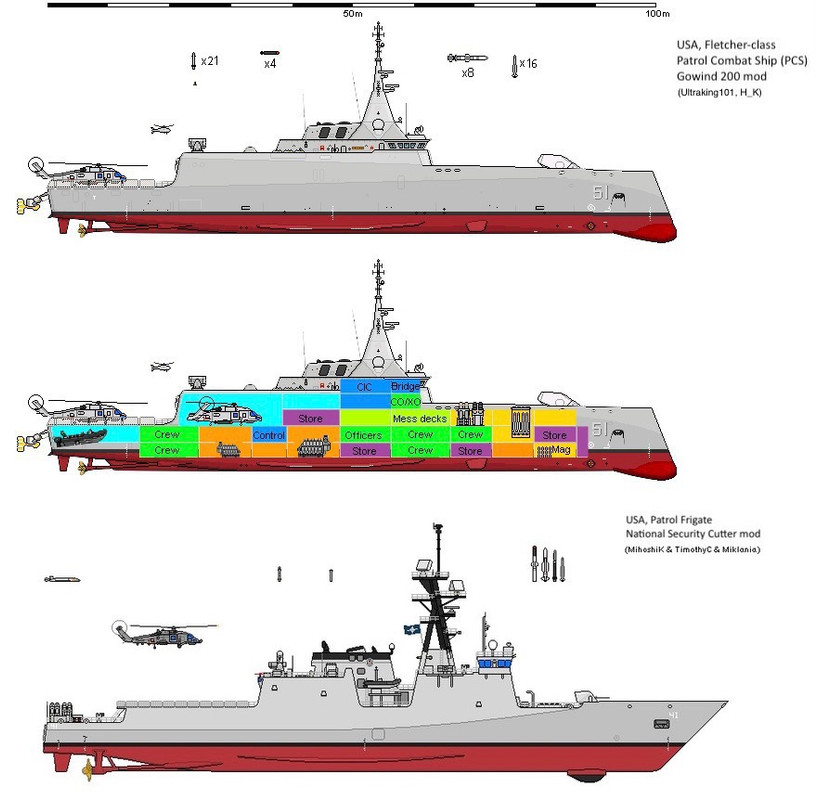
The key is to find the sweet spot where the patrol corvette is cheap and plentiful enough for peacetime, while still having some wartime utility in the Indopacific. Personally I would pay for it by reallocating the Coast Guard’s budget for OPC cutters to the USN, including moving some personnel.
Cost should be somewhat less than LCS (ie. One third to one half of a FFG-62), with additional weapons & ASW sensors offset by the simpler propulsion and smaller size.
From a design perspective, the low RCS design is meant to enhance survivability at low cost, compensating for the small size and limited armament. The CODAD propulsion includes 2 smaller cruise diesels and 2 sprint diesels, with the cruise diesels being silenced for ASW ops up to 20 knots and with waterline exhausts to reduce IR signature.
Ultimately it would compare well to the early Cold War frigates built by the USN, such as the Bronstein class:
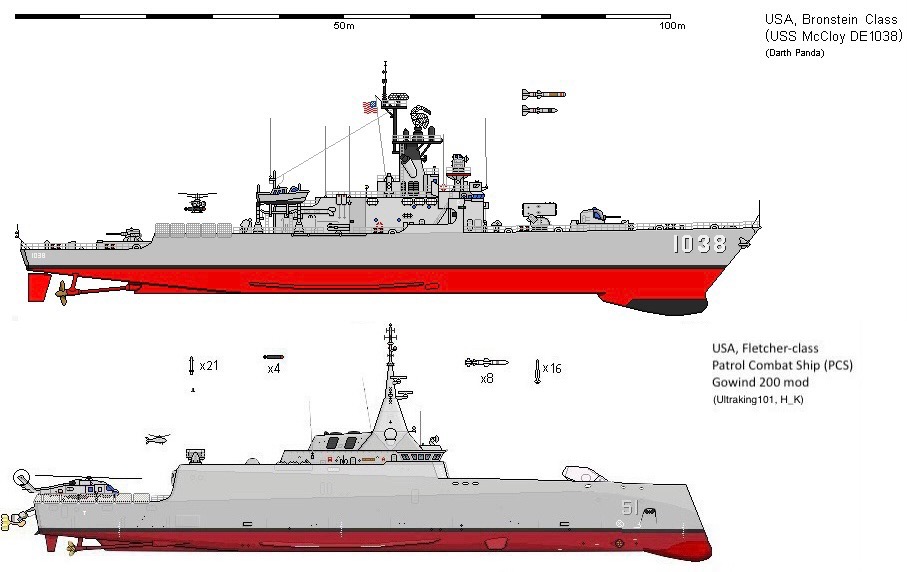
Last edited:
A Tentative Fleet Plan
I really should change my personal text
- Joined
- 9 April 2018
- Messages
- 946
- Reaction score
- 1,886
Maybe it can does those things. The MIW package is new. I don't think it's deployed with the MIW package yet.
The Freedom Class is being touted as the anti-boat swarm platform but it has yet to perform that mission. It's spent most of it's life tied to a pier waiting to get repaired.
The Independence class still have the 57mm and SeaRAM to keep the small boats at bay, and if the minesweeping UUVs and USVs, then the ship can maneuver freely outside the minefield, both of which capabilities are better than what the Avenger class MCMs can manage.
johnpjones1775
ACCESS: Secret
- Joined
- 27 May 2023
- Messages
- 207
- Reaction score
- 31
And yet the MMSC exists and is being built.LCS is hardly small, much larger than Streetfighter was intended to be.
LCS has a useful role as basically Minesweeper Mothership that can self-deploy and self-escort against enemy FACs and Boghammers, not as a general-purpose frigate.
Nice redirection though. The LCS was never supposed to be a general purpose ship. Each individual ship was supposed to have one purpose that it fulfilled based on the mission module it carried.
Yellow Palace the person I was responding to claimed that the people most familiar with the Cole attack did not seek to build large numbers of smaller/cheaper ships with less capabilities afterwards.
I was simply pointing out that, that exact thing is what happened. Within 3 years of the Cole attack the navy’s #1 priority was a program of small cheaper less capable ships.
johnpjones1775
ACCESS: Secret
- Joined
- 27 May 2023
- Messages
- 207
- Reaction score
- 31
Freedoms have already deployed to gulf, and I’m pretty sure the MCMA module likewise has been deployed.Maybe it can does those things. The MIW package is new. I don't think it's deployed with the MIW package yet.
The Freedom Class is being touted as the anti-boat swarm platform but it has yet to perform that mission. It's spent most of it's life tied to a pier waiting to get repaired.
Edit
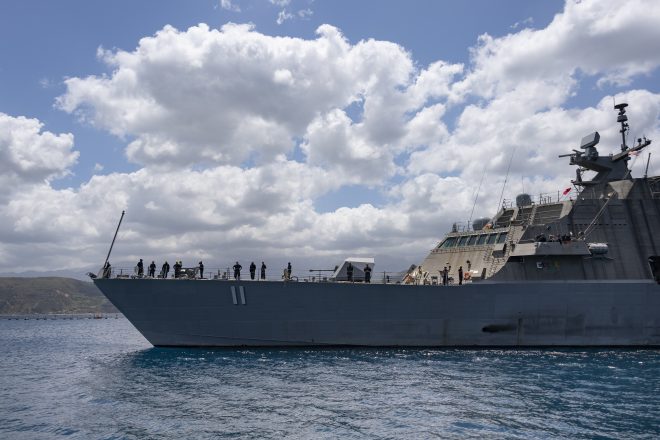
Littoral Combat Ship USS Sioux City Now Operating in the Middle East - USNI News
In a first for the class, a Freedom-variant Littoral Combat Ship is now operating in the Persian Gulf. USS Sioux City (LCS-11) chopped into 5th Fleet on Saturday after operating in U.S. 6th Fleet for nearly a month. “Sioux City is operating in support of a newly established multinational task...
MCM package is operational but has not deployed yet and is expected to forward based in Bahrain by 2025
A Tentative Fleet Plan
I really should change my personal text
- Joined
- 9 April 2018
- Messages
- 946
- Reaction score
- 1,886
If the US wants to keep the Malacca straits and assorted Indonesian straits bottled up, I'd suggest some diplomacy with the respective countries to see if seabed sensors can be placed there, not to mention getting the aid of Singaporean, Indonesian and potentially Australian SSKs.
Wouldn't really want to design a frigate or Corvette to perform that task.
Wouldn't really want to design a frigate or Corvette to perform that task.
- Joined
- 6 November 2010
- Messages
- 4,242
- Reaction score
- 3,185
Not for the US Navy, though? Correct me if I'm wrong.And yet the MMSC exists and is being built.
Instead, FFG(X) turned into the FREMM derived Constellations.
A Tentative Fleet Plan
I really should change my personal text
- Joined
- 9 April 2018
- Messages
- 946
- Reaction score
- 1,886
And yet the MMSC exists and is being built.
Hardly small or cheap though, and was originally planned with the an Aegis-derived combat system that you think is too expensive.
Of course this implies that a petro-state and absolutist monarchy like Saudi Arabia is actually capable of making wise military procurement decisions.
Nice redirection though. The LCS was never supposed to be a general purpose ship. Each individual ship was supposed to have one purpose that it fulfilled based on the mission module it carried.
Right, but LCS is not really a frigate and I don't think it should be compared to the frigates of other countries (or to anything like the Constellations). I don't view them as an alternative or replacement for General-Purpose frigates, I don't think they are capable enough to perform that role. They're great minesweeper replacements though, and I suppose they could act as competent combined Towed-Array tugs and platforms for ASW Helicopters when performing ASW for a fleet. Provided they're covered by DDGs to protect them from submarine-launched Anti-Ship Missiles though.
Yellow Palace the person I was responding to claimed that the people most familiar with the Cole attack did not seek to build large numbers of smaller/cheaper ships with less capabilities afterwards. I was simply pointing out that, that exact thing is what happened. Within 3 years of the Cole attack the navy’s #1 priority was a program of small cheaper less capable ships.
Said program was mostly a costly mistake, almost without without any form of redemption until a useful niche could be found for it, pushed into production by an overly technologically-optimistic Secretary of Defense and Admiral working in concert. Of course the original Streetfighter concept was unworkable, which is why LCS swelled form a displacement around 1000-tons to 3500-tons, I to something that wasn't just an overgrown FAC.
Freedoms have already deployed to gulf, and I’m pretty sure the MCMA module likewise has been deployed.
Edit

Littoral Combat Ship USS Sioux City Now Operating in the Middle East - USNI News
In a first for the class, a Freedom-variant Littoral Combat Ship is now operating in the Persian Gulf. USS Sioux City (LCS-11) chopped into 5th Fleet on Saturday after operating in U.S. 6th Fleet for nearly a month. “Sioux City is operating in support of a newly established multinational task...news.usni.org
MCM package is operational but has not deployed yet and is expected to forward based in Bahrain by 2025
Once. They made it once. After so many years they were able to sail their and back. Once
It's delusional to call this class successful.
Hopefully there is some utility that can be coaxed from them but so far it has been an expensive catastrophe.
The ocean-going corvette would be built to handle multiple patrol requirements, including replacing the OPC cutters in peacetime. In wartime, they would escort replenishment vessels and ships from the continental US, patrol off naval bases (Pearl Harbor, San Diego, Guam etc), cover the Indian and Atlantic oceans etc.If the US wants to keep the Malacca straits and assorted Indonesian straits bottled up
Wouldn't really want to design a frigate or Corvette to perform that task.
Patrolling chokepoints would be just one of many missions… personally I doubt that allies or undersea sensors would be sufficient especially given the need to also do VBSS to interdict merchant shipping and enforce trade sanctions.
There is a one area where cheap simple corvettes/OPVs could be very useful. That is the myriad of peacetime commitments (showing the flag, piracy patrols, interdicting drug runners, etc) the USN has to conduct but don't require a Burke or even a Constellation for. Note that this is not for boosting the navy in wartime. If you had a bunch of cheap OPVs for peacetime duties, you could then keep the higher end combatants in port for much longer saving on maintenance and making sure your high end fleet is not worn out when a war with a peer combatant breaks out. The OPVs would not actually have a wartime role and their crews would go to beef up the higher end ships in combat.
There is a one area where cheap simple corvettes/OPVs could be very useful. That is the myriad of peacetime commitments (showing the flag, piracy patrols, interdicting drug runners, etc) the USN has to conduct but don't require a Burke or even a Constellation for. Note that this is not for boosting the navy in wartime. If you had a bunch of cheap OPVs for peacetime duties, you could then keep the higher end combatants in port for much longer saving on maintenance and making sure your high end fleet is not worn out when a war with a peer combatant breaks out. The OPVs would not actually have a wartime role and their crews would go to beef up the higher end ships in combat.
I see the utility in your concept but I don't see the US Navy going for it.
Anything they invest in is going to have to have some useful wartime role.
The US is behind the eight ball in naval shipbuilding and they are struggling to replace the aging combatants they have now.
I don't think it's a dollar issue as much as it's a shipyard capacity issue.
The closest thing to your concept is the Coast Guard's NSC and new OPCs. They are very capable in the show-the-flag, anti-piracy and anti-smuggling roles but are so lightly armed as to be not very useful in peer naval conflict.
Hardly small or cheap though, and was originally planned with the an Aegis-derived combat system that you think is too expensive.
Of course this implies that a petro-state and absolutist monarchy like Saudi Arabia is actually capable of making wise military procurement decisions.
Right, but LCS is not really a frigate and I don't think it should be compared to the frigates of other countries (or to anything like the Constellations). I don't view them as an alternative or replacement for General-Purpose frigates, I don't think they are capable enough to perform that role. They're great minesweeper replacements though, and I suppose they could act as competent combined Towed-Array tugs and platforms for ASW Helicopters when performing ASW for a fleet. Provided they're covered by DDGs to protect them from submarine-launched Anti-Ship Missiles though.
Said program was mostly a costly mistake, almost without without any form of redemption until a useful niche could be found for it, pushed into production by an overly technologically-optimistic Secretary of Defense and Admiral working in concert. Of course the original Streetfighter concept was unworkable, which is why LCS swelled form a displacement around 1000-tons to 3500-tons, I to something that wasn't just an overgrown FAC.
Experiments were performed with LCS and towed arrays but the results were not positive. The Navy has abandoned any hope of using LCS with towed array.
The Navy deemed LCS as not suitable for anti-submarine work but did not give a detailed explanation.
The rumor is they are just too loud.
Similar threads
-
-
-
Could a Type 12 or other frigate have carried a worthwhile SAM?
- Started by uk 75
- Replies: 111
-
Need help translating russian for sensor & weapon types
- Started by fedf111fan
- Replies: 4
-

